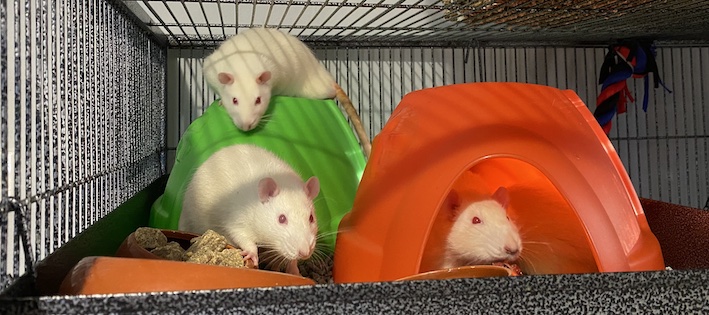At Liberty Foundation we receive some beautiful rats from research facilities and over the years we’ve learnt a thing or two about what makes the perfect home for our rodent friends.
We wanted to share with you some tips on providing the best accommodation and lifestyle for rats, who we usually rehome as compatible pairs or trios.
If you’d like to express your interest in adopting or fostering rats just fill out our form here.
Housing
There are three types of housing that we believe make the best homes for rats and ensure that they are kept happy, comfortable and stimulated.
For 2-4 rats we recommend the large cages on wheels that are around 140cm tall by 55m deep and 80cm long.
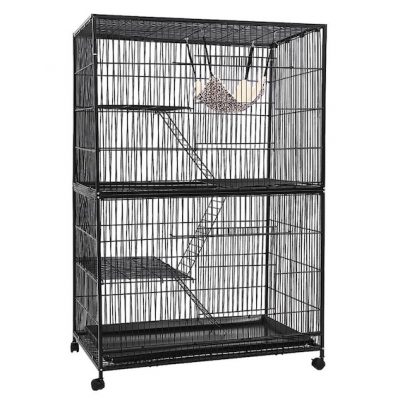
Just ensure you have ladders or hammocks to enable the rats to reach all levels of the cage. We especially like these cages because you can build a simple corflute or perspex base in them to contain a digging box (see more on digging boxes below).
For two rats you can use a cage like the one shown below with dimensions of around 160cm tall (including stand) by 50cm deep by 80cm long. This has a large door in the front for easy access and enough space to set up hammocks, ramps and hidey places.
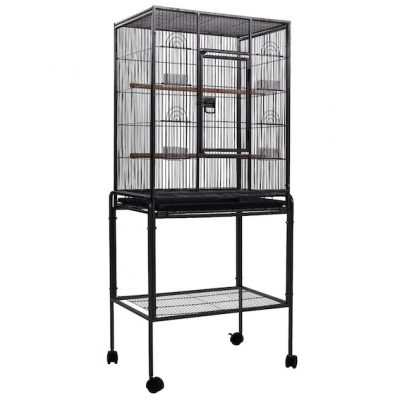
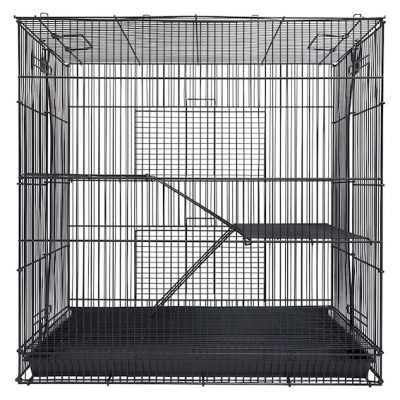
It is also acceptable to use a smaller cage for two rats like the one shown here, which is around 60cm tall by 40cm deep by 60cm long. But only if your rats will spend a good amount of time outside of the cage or you are spending a lot of time interacting with them.
This style of cage is fine to use if your rats have their own area or room and you leave the cage door open for them to come and go, for example. This type of cage is not large enough for two rats to live in full-time.
There are many places online where you can purchase these types of cages so shop around as there is a great variation in price. It’s generally cheaper to purchase online than from retail stores. Better still, buy them second hand on Facebook Marketplace – that’s where we get most of our cages.
One important thing to remember: Ensure the bar spacing (and any other gaps) are not wider than two centimetres apart for adult rats. If your rat can fit their head through a gap, then they can get their body through!
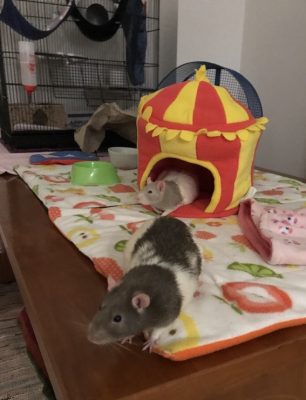
Design
We like to include all kinds of fun things for our rats to do. Although we like them to have time outside their cage every day for a safe free-roam experience or snuggle with their owner, it’s good to provide a roomy and varied cage environment for them to explore overnight.
Your cage design can be as creative as you like and the sky is the limit. It’s advisable to have plenty of hiding areas, like wooden or plastic houses, hammocks or even cardboard boxes. One of our favourites is the large Sputnik (see pic below) – it’s easy to clean and they love lounging in it.
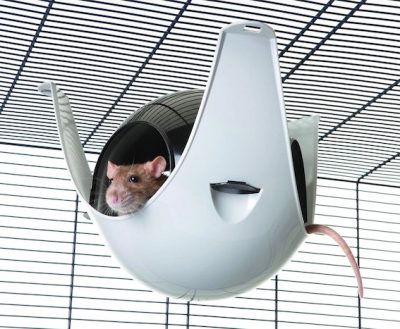
Aside from places to rest and hide, there should be opportunities to jump and climb. We recommend ladders, thick ropes, rattan, dried logs or branches, hanging baskets and seagrass matting. You can offer a running wheel but most rats are not that interested in them.
Just remember, wherever there is a surface your rat will be walking along that is metal grids or mesh, just cover it in order to protect their feet. Rats that walk on mesh can get very sore feet otherwise known as bumblefoot. You can cover metal grids or mesh with fabric or cloth (attached with cable ties or bulldog clips) or weave rattan through it.
It is a natural behaviour of all rodents to dig and we like our rats to have the opportunity to do this, either in hemp fibre bedding or coir peat (which you can buy cheaply from Bunnings and rehydrate with water). You can also fill a digging box with shredded paper. Just stay away from anything that will create dust as this can hurt their lungs.
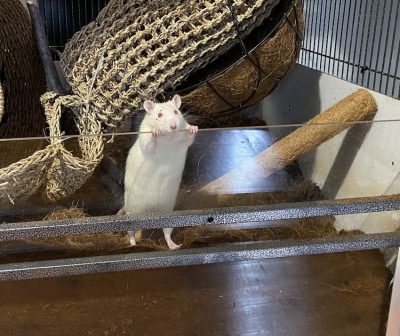
It’s also important not to include anything in their cage environment with a strong scent as this can also affect their breathing.
Always bear in mind that you want to create an environment for your rats that is safe, comfortable and fun but also easy to maintain You don’t want to spend the whole time cleaning! One good thing is that rats are generally very clean and will use a litter box if you provide one – a large, shallow plastic container is fine, filled with a paper pellet litter or something similar. You can line the bottom of your cage with newspaper or paper towel and just change this every few days.
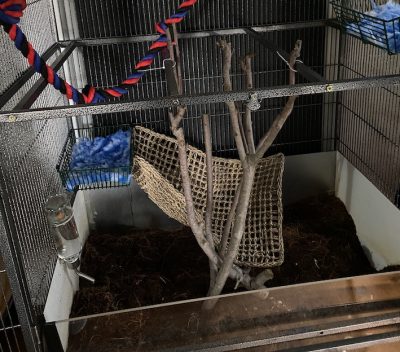
It’s not recommended to get into their nesting areas and clean them out every day because this can upset them. It’s best to spot clean during the week and then do a bigger clean once a week to change their bedding and clear out any food or tasty treats they may have stashed away! Some rats will stash, some won’t, it just depends on their nature.
Location
The best place for rat housing is inside your home. They don’t generate any odour (if you keep their environment clean) so it’s easy to keep them near you and they also enjoy the chance to interact with you. Also, you don’t need to clean or wash your rats, they can take care of that themselves! If they are looking scruffy or ungroomed it can in fact be a sign that they’re not feeling too well.
Unless you want to be kept up all night (or you are a heavy sleeper) we wouldn’t recommend having them in your bedroom. Rats are nocturnal and are mostly active from dusk until dawn.
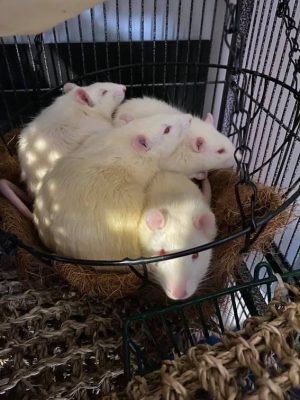
We don’t recommend having them in garages as it is too difficult to control the temperature and humidity and they often get too hot.
As a general rule of thumb, if you find an environment too hot or cold, then your rats will as well. They like a temperature range around 18-26 degrees Celsius.
Make sure you also don’t house rats in noisy or busy environments as this may frighten them or disturb them during the day when they are resting. With albino (pink eyed) rats it’s also good not to have harsh overhead lighting or direct sunlight as this will damage their eyesight.
If you are allowing your rats free-roam time, just ensure they are safe and contained, away from other animals or situations where they may get injured. It’s not advisable to take them outdoors.
Health
Our rats are generally not desexed so they are rehomed in same-sex groups, although there are benefits to desexing such as greater longevity and less age-related health issues.
We can always advise on good exotics vets who will assist you with desexing or any health issues your rat may experience during their life.
We usually get albino female rats of the Sprague Dawley or Wistar strains. Occasionally we receive hooded rats which are multi-coloured with dark eyes. The lifespan of our rats is generally 2-2.5 years if they maintain good health.
Our rats do not have mycoplasma (respiratory illness) which can be present in other rats. We are therefore very careful about rehoming them in places with other rats. This is possible as long as you are willing to keep the ex-research rats separate from other rats with their own caging and equipment. If you do have other rats with symptoms of mycoplasma you just need to be careful about not transmitting this, by washing your hands and disinfecting food bowls etc.
If your rat was to develop mycoplasma we can provide advice on the best treatment options available to help manage the condition and extend their life.
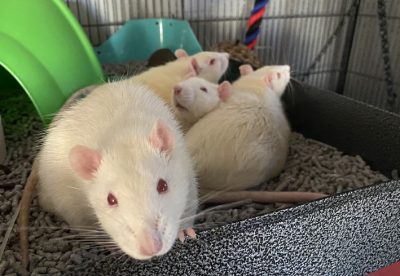
Final thoughts
There are some fantastic channels on YouTube explaining best practice in keeping and caring for rats.
While there might be an initial outlay in setting up the ultimate rat paradise, it’s worth it in the long run because these systems are durable, easy and inexpensive to maintain, and will ensure your little mates remain happy and healthy for the duration of their lives.
We’re always here to help and offer advice on where you can get more information or purchase supplies for these delightful critters.
Just reach out anytime to have a chat – hello@libertyfoundation.org.au
If you’d like to express your interest in adopting or fostering rats just fill out our form here.

